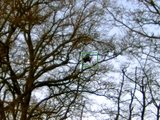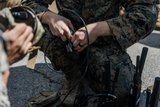Swiss soldier system development on track
The Integrated and Modular Engagement System for the Swiss Soldier (IMESS) solution developed by Airbus Defence and Space (D&S) has been completed to the level necessary for series production on schedule, the company announced on 30 July.
IMESS, which has already completed technical acceptance by the Swiss procurement authority, will now begin field tests which will run for the next two years.
Airbus D&S received the €19 million contract in 2011 to develop a high-tech soldier system for the Swiss Army as part of its soldier modernisation programme. IMESS gives soldiers improved command-and-control capabilities from company level to individual soldier level through the integration of combat vehicles, including computer and radio connections.
Radio communications have been optimised with increased range and new standardised equipment. Head/helmet mounted displays also give soldiers clearer situational awareness and improved navigation.
A modular architecture provides numerous standard interfaces to sensors, such as a thermal imaging device, as well as modules for link-up with external systems, such as unmanned aircraft; while the overall weight and energy balance of the equipment has also been improved.
Under the terms of the contract Airbus D&S will also provide logistical support for this project.
More from Digital Battlespace
-
![Chess Dynamics successfully demonstrates Vision4ce AI-driven tracker]()
Chess Dynamics successfully demonstrates Vision4ce AI-driven tracker
The Vision4ce Deep Embedded Feature Tracking (DEFT) technology software is designed to process video and images by blending traditional computer vision with artificial intelligence (AI) algorithms to present actionable information from complex environments.
-
![Wave Relay devices cleared for security use on commercial systems in industry trend]()
Wave Relay devices cleared for security use on commercial systems in industry trend
Persistent Systems has been cleared by National Security Agency (NSA) to transmit sensitive data on commercial networks. The devices are added to the NSA’s Commercial Solutions for Classified (CSfC) component list which also includes other companies’ products providing the same security.
-
![UK teases cyber spending boost in Strategic Defence Review ahead of “imminent” release]()
UK teases cyber spending boost in Strategic Defence Review ahead of “imminent” release
The release of the UK’s Strategic Defence Review (SDR) has been long promised as mid-year. It is possible it could be as early as 2 June although the UK Ministry of Defence (MoD) continues to play its cards close to its chest.
-
![Intelsat emphasises SATCOM resilience for SOF in contested domains (video)]()
Intelsat emphasises SATCOM resilience for SOF in contested domains (video)
Intelsat outlines how its multi-orbit SATCOM architecture is enhancing connectivity and resilience for special operations forces operating in degraded and contested environments.
-
![US Space Force’s next-generation missile warning system moves forward with $500 million in new contracts]()
US Space Force’s next-generation missile warning system moves forward with $500 million in new contracts
Next-Generation Overhead Persistent Infrared (Next-Gen OPIR) satellites are intended to provide early warning of missile launches from any location worldwide and new ground stations will result in expanded coverage of critical missile warning.
























